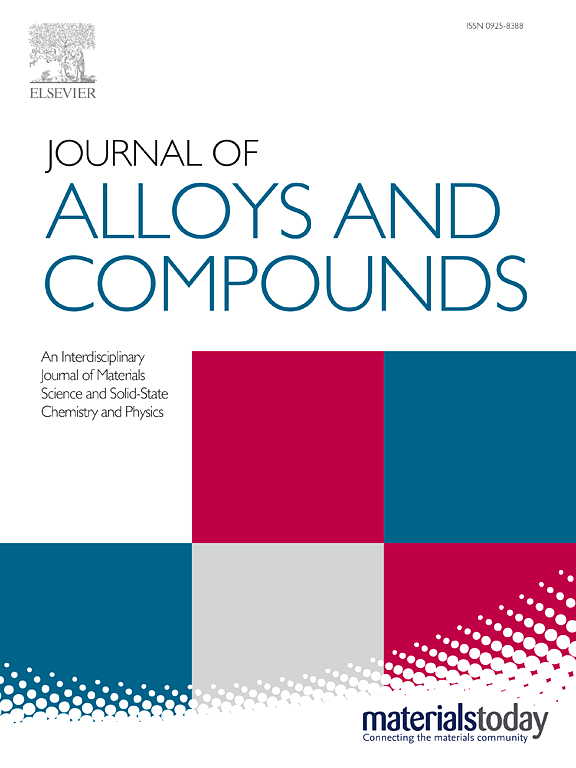激光粉末床熔合制备W-HfC合金过程中HfC的独特演变及其对组织和力学性能的影响
IF 5.8
2区 材料科学
Q2 CHEMISTRY, PHYSICAL
引用次数: 0
摘要
相对较低的密度、柱状晶体结构和裂纹一直是激光粉末床熔合(LPBF)制备的钨或钨合金获得优异力学性能的不可避免的障碍。将HfC颗粒引入钨中,研究其对钨合金抗裂性能和力学性能的影响。特别对LPBF过程中可能发生的反应和HfC颗粒的演化进行了热力学分析。发现HfC分解后的Hf和C在冷却过程中进入W晶格形成取代固溶体,与W反应生成碳化钨,充当胞壁结构。同时,添加的微米级HfC颗粒在LPBF过程中经历熔融、再凝固再生。微观结构分析表明,再生的纳米级HfC纳米颗粒与W基体的晶体取向关系为(200)HfC // (110)W和[0′1′1′1′1]HfC // [001]W。热应力的缓解和碳化物颗粒的均匀分散不仅抑制了裂纹的发生,而且使晶粒从47.0 μm细化到34.6 μm,柱状晶结构发生改变,晶粒的强度和强度减弱;// BD纹理。结合固溶强化,W-HfC合金的最大抗压强度可达1832 MPa。阐明激光增材制造过程中碳化物颗粒的演化规律,为激光增材制造过程中基于点阵匹配的W合金合理的碳化物强化相提供了可行的策略。本文章由计算机程序翻译,如有差异,请以英文原文为准。

The unique evolution of HfC during laser powder bed fusion manufacturing W-HfC alloys and its influence on the microstructure and mechanical properties
Relatively low density, columnar crystal structure and cracks are always the inevitable hurdles in achieving excellent mechanical performance for tungsten (W) or tungsten alloys manufactured by laser powder bed fusion (LPBF) process. In this work, HfC particles were introduced to tungsten (W) to investigate their influence on cracking inhibition and mechanical properties of W alloys. Particularly, possible reactions and evolution of HfC particles during the LPBF process were analyzed thermodynamically. It was found that Hf and C, decomposed from HfC, would enter into W lattice to form substitution solid solution and reacted with W to form tungsten carbides during the cooling process, acting as the wall of cellular structure. Meanwhile, the added micron-sized HfC particles went through melting, re-solidification to regenerate during the LPBF process. Microstructure examination indicated that the crystallographic orientation relationship between re-generated nano-sized HfC nanoparticles and W matrix was (200)HfC // (110)W and [01]HfC // [001]W due to the small lattice mismatch and low interface energy between them. Mitigated thermal stress and uniformly dispersed carbide particles not only suppressed cracking but also refined the grains from 47.0 μm to 34.6 μm and altered columnar crystal structure with weakened <111>// BD texture. Together with solid solution strengthening, the maximum compressive strength of W-HfC alloys reached 1832 MPa. The elucidation about the evolution of carbide particles during the LPBF process may provide an applicable strategy for a reasonable carbide strengthening phase for W alloys based on lattice matching during laser additive manufacturing process.
求助全文
通过发布文献求助,成功后即可免费获取论文全文。
去求助
来源期刊

Journal of Alloys and Compounds
工程技术-材料科学:综合
CiteScore
11.10
自引率
14.50%
发文量
5146
审稿时长
67 days
期刊介绍:
The Journal of Alloys and Compounds is intended to serve as an international medium for the publication of work on solid materials comprising compounds as well as alloys. Its great strength lies in the diversity of discipline which it encompasses, drawing together results from materials science, solid-state chemistry and physics.
 求助内容:
求助内容: 应助结果提醒方式:
应助结果提醒方式:


